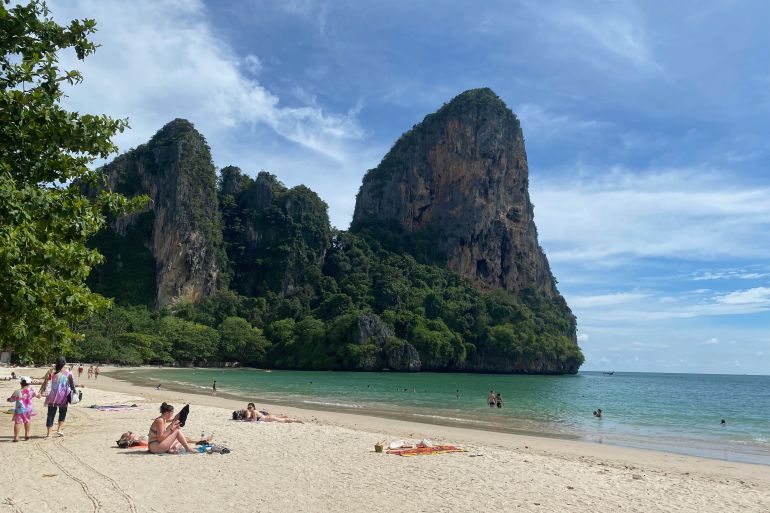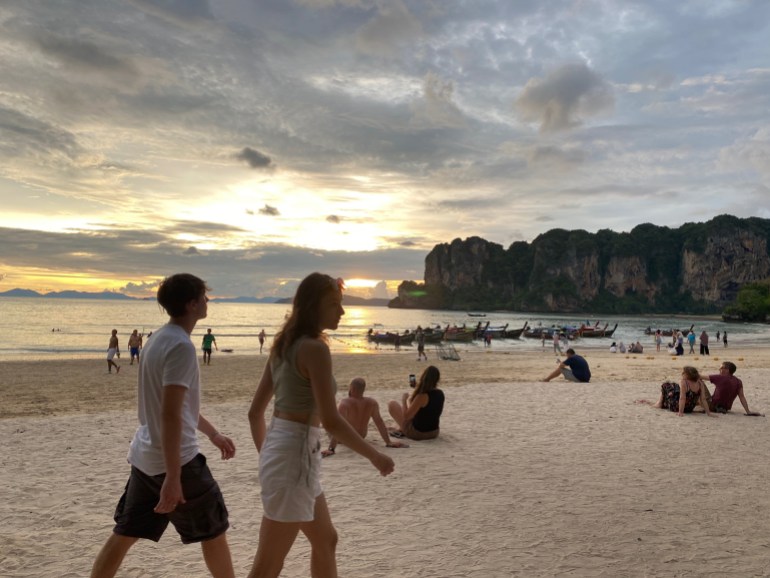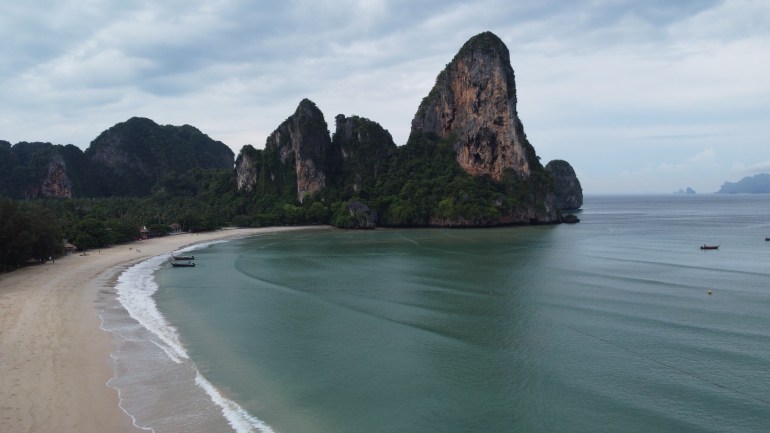After reopening, Thailand’s battered tourism struggles to rebuild
Authorities hope 5 to 15 million visitors will visit the country this year, down from 40 million before the pandemic.

Krabi, Thailand – At Railay Beach, an Instagrammers’ favourite known for its wide, warm sands bookended by limestone cliffs, 23-year-old Londoner Becca sips coffee and savours the return of Thai backpacking following a recent easing of entry requirements.
“We saved our money, quit work and travelled here,” she told Al Jazeera of her months-long trip with friends, which was impossible during the last two years lost to the pandemic.
Keep reading
list of 4 itemsSomalia elects new president after long overdue elections
One killed, five wounded in California church shooting
N Korea deploys army as WHO expressed ‘concern’ over COVID
Thailand was one of the first places in the world to reopen to tourists late last year, but under a confusing web of rules – including seven-day quarantine – travellers complained the small print failed to match the big announcements.
Meanwhile, horror stories of people testing positive on arrival and being shunted into 14-day quarantine – paid for from their own pocket – bounced around travel blogs and Twitter.
On May 1, Thailand dropped its “Test & Go” quarantine procedure, allowing vaccinated visitors to enter freely, while an onerous pre-departure registration scheme known as the “Thailand Pass” is likely to also be abandoned within weeks.
Authorities hope the result will be between 5 and 15 million overseas visitors by year-end, as the Southeast Asian country prepares to declare the coronavirus endemic and throws open the door to a travel-starved world.

On Railay beach, bars and restaurants already hum with backpackers, many knocking back beers to a loud techno soundtrack as the sun dips behind the ocean.
As far as Becca is concerned, the island-hopping route across Koh Phangan, Koh Samui, Phi Phi and Koh Tao is firmly back in business.
“It’s so cheap here, compared with where we’re from,” she said. “It’s such a treat to have a meal for two pounds.”
A 10-minute walk to the more rugged east side of the coast, tour operator Naren Fangkwa is less enthusiastic as he laments the continued absence of wealthier tourists to one of Thailand’s top destinations.
Naren believes many high-end visitors have been frightened off by the kingdom’s constantly changing entry rules.
“Since borders opened, visitors are mainly young people like uni students and backpackers who don’t really buy tour packages,” he said.
Many restaurants on Naren’s side of Railay get by on handfuls of customers, while several others remain shut, victims of a pandemic that has smashed one of the country’s most crucial industries.

Despite the banner headlines about reopening, tourism is still far below pre-pandemic levels, when it attracted nearly 40 million people and generated more than $60bn of revenue, accounting for up to a fifth of the kingdom’s gross domestic product.
Last month, forward bookings for 2022 showed Thailand had reached 25 percent of normal levels, compared with 72 per cent and 65 percent each for Singapore and the Philippines, respectively.
Nevertheless, the kingdom expects those who do visit between now and year-end – the majority from Europe, the United States, the Middle East and India – to spend at least 630 billion baht ($18bn) in the country, providing a much-needed boost to incomes as inflation chews into purchasing power.
Halal tours
Krabi, whose population is 40 percent Muslim, is particularly well-placed to pull in an expected surge in Middle Eastern visitors, with “halal tours” offering a mix of sightseeing, religious visits and food.
“We’re planning to tap the Middle Eastern market this year, especially Saudi Arabia,” Sasithorn Kittidhrakul, president of Krabi Tourism Association, told Al Jazeera.
“It’s a high-end market for us and Krabi has what it takes to cater to the health and wellness conscious tourists.”
Sasithorn said bookings at the province’s hotels are running at 30 percent for the next high season of October to March.
So far, bold projections of one million visitors a month are yet to be felt across the grassroots economy of Krabi, where most families count several members employed in tourism.

Driver Sorapong Kuasuk said high-spending tour groups are yet to reappear and blames months of mixed messaging from the government for deterring bookings.
“Tourists are going to go to other countries that have clearer COVID measures,” he said, condemning Thailand’s months-long debate over ending quarantine on entry.
“Everyone knows that if the Thai authorities announce one thing in the morning they will change it by the evening. I think it’ll be a while before tourists feel more confident to return.”
Bigger economic forces also threaten the outlook for Thailand’s tourism reboot.
Surging living costs are eating into the disposable incomes of the world’s middle class.
Earlier this month, analysts at J P Morgan issued a pessimistic outlook for Thailand’s economic recovery, due in part to the lack of a timetable for the return of Chinese tourists under Beijing’s draconian “dynamic zero COVID” policies.
From Krabi to Phuket and Pattaya, Thai resorts do not expect a return to the boom times until Chinese visitors, who made up more than one-quarter of arrivals before the pandemic, come back.
For the tour operators of Railay, the next few months are about survival.
“We barely make 5 percent back of what we used to before COVID,” Atittaya Kajay, who sells boat trips to nearby islands, told Al Jazeera.
“People spend less now, they want bargains when before they were all higher end, people with money”.